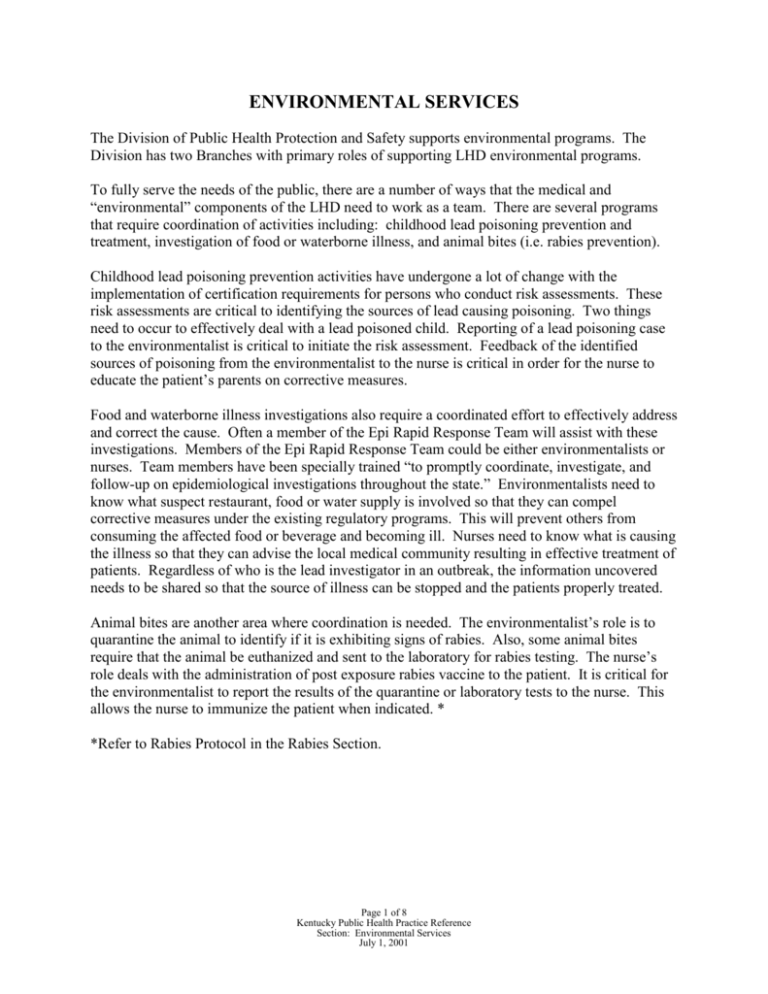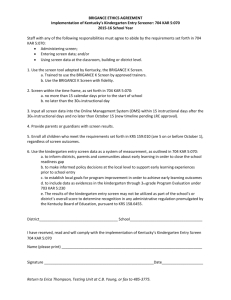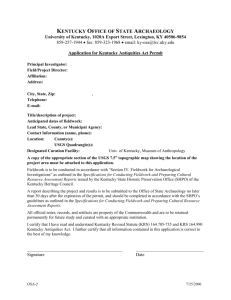environmental services - Green River District Health Department
advertisement

ENVIRONMENTAL SERVICES The Division of Public Health Protection and Safety supports environmental programs. The Division has two Branches with primary roles of supporting LHD environmental programs. To fully serve the needs of the public, there are a number of ways that the medical and “environmental” components of the LHD need to work as a team. There are several programs that require coordination of activities including: childhood lead poisoning prevention and treatment, investigation of food or waterborne illness, and animal bites (i.e. rabies prevention). Childhood lead poisoning prevention activities have undergone a lot of change with the implementation of certification requirements for persons who conduct risk assessments. These risk assessments are critical to identifying the sources of lead causing poisoning. Two things need to occur to effectively deal with a lead poisoned child. Reporting of a lead poisoning case to the environmentalist is critical to initiate the risk assessment. Feedback of the identified sources of poisoning from the environmentalist to the nurse is critical in order for the nurse to educate the patient’s parents on corrective measures. Food and waterborne illness investigations also require a coordinated effort to effectively address and correct the cause. Often a member of the Epi Rapid Response Team will assist with these investigations. Members of the Epi Rapid Response Team could be either environmentalists or nurses. Team members have been specially trained “to promptly coordinate, investigate, and follow-up on epidemiological investigations throughout the state.” Environmentalists need to know what suspect restaurant, food or water supply is involved so that they can compel corrective measures under the existing regulatory programs. This will prevent others from consuming the affected food or beverage and becoming ill. Nurses need to know what is causing the illness so that they can advise the local medical community resulting in effective treatment of patients. Regardless of who is the lead investigator in an outbreak, the information uncovered needs to be shared so that the source of illness can be stopped and the patients properly treated. Animal bites are another area where coordination is needed. The environmentalist’s role is to quarantine the animal to identify if it is exhibiting signs of rabies. Also, some animal bites require that the animal be euthanized and sent to the laboratory for rabies testing. The nurse’s role deals with the administration of post exposure rabies vaccine to the patient. It is critical for the environmentalist to report the results of the quarantine or laboratory tests to the nurse. This allows the nurse to immunize the patient when indicated. * *Refer to Rabies Protocol in the Rabies Section. Page 1 of 8 Kentucky Public Health Practice Reference Section: Environmental Services July 1, 2001 ENVIRONMENTAL MANAGEMENT BRANCH PROGRAMS Description: The mission of the Environmental Branch is to prevent disease and eliminate existing unsanitary conditions and safety hazards in public facilities and the individual’s personal environment. The branch establishes sanitary standards of operation, issues permits to operate public facilities and to construct on-site sewage disposal systems and sewage treatment sites, trains and certifies onsite sewage disposal system inspectors, certifies training and service providers regarding septic system installers, conducts review and approval of construction plans for onsite sewage components and public swimming and bathing facilities, conducts product safety programs related to consumer products, conducts and coordinates radon mitigation training and public education programs, and evaluates LHD programs. Resources are directed primarily at providing training and technical assistance to LHD. Programs are also evaluated based on the program standards in 902 KAR 8:028. Clients: Septic system installers, septic tank pumpers, hotels and motels, swimming pools and bathing facilities, state confinement facilities, mobile home parks, recreational vehicle parks, youth camps, and product manufacturers are regulated under the authority of their respective regulations. Citizens may also have public health nuisances investigated and corrected through LHD (pursuant to KRS 211.210 and KRS 212.210). Citizens can also have water samples collected and analyzed for chemical and biological contaminants. Services: 1. Construction plan review done by LHD environmental staff. 2. Training of regulated establishment managers and workers. 3. Training of LHD inspectors. 4. Permit issuance and inspections of regulated public facilities. 5. Certification of septic system installers by LHD. 6. Investigation of public health nuisances by LHD. 7. Enforcement – notices, permit suspension, injunctive action, etc. where necessary. 8. Response to consumer complaints. 9. Consumer education – presentations, materials, etc. Anyone suspecting a problem or issue relative to the above may contact the LHD or the Environmental Management Branch. Training: Twice yearly training sessions are conducted for each level of eight certification of septic system inspectors. Annual CORE training is conducted for LHD inspectors in all other programs. Page 2 of 8 Kentucky Public Health Practice Reference Section: Environmental Services July 1, 2001 FOOD SAFETY BRANCH PROGRAMS Description: The Food Safety Branch is mandated by law (KRS Chapter 217) to protect consumers from the sale of adulterated and misbranded foods and food products; KRS 216B.300 to protect consumers residing in boarding homes; and KRS 211.760 to register tattoo artists. In addition, the administrative regulation governing the registration of tattoo artists and certification of tattoo studios is 902 KAR 10:045. The branch provides technical assistance and support to LHDs who carry out the state laws and regulations to accomplish consumer protection. Programs are evaluated based on the program standards in 902 KAR 8:028. Clients: Food safety and food product labeling standards are applicable to food processors; food storage warehouses; food salvage processors and distributors; retail food establishments (retail food stores, restaurants, lunchrooms and cafeteria facilities in education, health care, confinement and other institutions); vending machine companies; and bed and breakfast homes. Boarding homes and tattoo parlors are regulated under the authority of their respective regulations. Services: 1. Consultation and guidance provided to LHD food inspection staff. 2. Foodborne illness investigation response in cooperation with other branches. 3. Standardization of LHD Retail Food Specialist(s), as well as County/District Food Program Evaluations. 4. Inspection and monitoring of special event food operations (State Fair). 5. Development of Food Safety Training Materials for use by LHDs and the Food Safety Branch, to help provide training to industry. 6. Develop Food Safety Educational Materials for the general public as well as a program to be directed to school children. 7. Develop and issue Food Safety related news releases to general public. 8. Formulate and disperse to all LHDs any food related recalls concerning Kentucky Food Safety. 9. Develop partnerships and cooperation among other related agencies, such as FDA, USDA, Kentucky Academia and Food Related Industry. 10. Construction plan review done by LHD environmental staff. 11. Training and regulated establishment managers and workers. 12. Permit issuance and inspections of food establishments. 13. Certification of tattoo studios by LHDs. 14. Registration of tattoo artist by LHDs. 15. Registration and inspection of boarding homes. 16. Enforcement – notices, permit suspension, injunctive action, etc. where necessary. 17. Food product label review. 18. Food sample collection and analysis for safety and quality assurance. 19. Response to consumer complaints. 20. Consumer education – presentations, materials, etc. Anyone suspecting a problem relative to the above may contact the LHD or the Food Safety Branch at. Page 3 of 8 Kentucky Public Health Practice Reference Section: Environmental Services July 1, 2001 Training: Annual CORE training is provided to new local health environmentalists. A new Food Safety Training Video has been developed with assistance from the FDA Cincinnati District Office to be used to train local health environmentalists across the state, and will be used by LHDs for training and educating the retail food industry and consumers. Regulations and policies of the department provide operation procedures and guidance for food safety and environmental programs. Equipment required, average times determined for conducting specific services; and personnel minimum qualification requirements are addressed in the department’s program standards found in 902 KAR 8:028. State Technical Consultants, who have been certified by the Food and Drug Administration, provide training, standardization, and evaluations of LHD food inspectors and the programs administered by them. State and LHD Environmental Services personnel are required by KRS 223.010 to 223.080 to become registered and to earn annual continuing educational credits to maintain registered status in order to conduct environmental service activities. LHD program managers may perform self-evaluations utilizing the department’s program standards, along with comparison of program output with department standardization and evaluation guidelines. Page 4 of 8 Kentucky Public Health Practice Reference Section: Environmental Services July 1, 2001 MILK SAFETY BRANCH PROGRAMS Description: The Milk Safety Branch is mandated by law (KRS Chapter 217) to protect consumers from the sale of adulterated, misbranded, or falsely advertised milk and milk products. This is accomplished through program standards identified by Interstate Milk Shipments (IMS), Food and Drug Administration (FDA) and the United States Department of Agriculture (USDA). Programs are evaluated based on the program standards in 902 KAR 50:110:902 KAR 50:031; 902 KAR 50:032; 902 KAR 50:033; 902 KAR 50:040; 902 KAR 50:080; 902 KAR 50:120. Clients: Dairy producers, milk truck owners, dairy processing plants, frozen dessert plants, and this branch permit single service plants. Consumer complaints are investigated, resolved and/or forwarded to the dairy processor for disposition. Services: 1. Construction plans received and approved. 2. Permit issuance to dairy farm producers, milk truck owners, milk haulers, processing plants and single service plants. 3. Training and recertification of milk haulers and sample collectors. 4. Pasteurization courses for dairy industry personnel. 5. Response and/or investigation of consumer complaints. 6. Mandated inspections of dairies, milk trucks, processing plants and single service plants. 7. Enforcement – notices, permit suspensions, injunctive action, etc. where necessary. 8. Milk and dairy product label review. 9. Sampling of water supplies and finished dairy products. 10. Consumer education, presentations, materials, etc. 11. Accredited Interstate Milk Shipments Laboratories. Training: All new employees receive on-job-training before being assigned a work area. All employees are encouraged to take advantage of pertinent training courses presented outside the branch. State Public Health Protection and Safety personnel are required by KRS 222.10 to 223.080 to become registered and to earn annual continuing educational credits to maintain registered status in order to conduct Milk Safety Branch activities. Page 5 of 8 Kentucky Public Health Practice Reference Section: Environmental Services July 1, 2001 RADIATION HEALTH AND TOXIC AGENTS BRANCH PROGRAMS Description: The mission of the Radiation Health and Toxic Agent Branch is to: (1) ensure the beneficial use of radiation; (2) protect the public from unnecessary exposure to the harmful effects of radiation, and (3) protect the citizens in the nine county areas surrounding the Bluegrass Army Depot from the impacts of chemical warfare agents. The Radiation Health Programs are responsible for licensure, registration, and certification of all uses of radiation. The program conducts inspections, reviews and validates environmental surveillance data, and manages compliance activities. The Program is responsible for statewide emergency response to radiological incidents and emergencies and is equipped to respond to radiological emergencies 24 hours a day (Kentucky Emergency Management Duty Office 502564-7815). The Radiation Health Program reviews and validates all data related to the Maxey Flats Disposal Site that is presently undergoing superfund remediation under a Court Ordered Consent Decree. Maxey Flats Disposal Site information can be obtained and/or reviewed at the Radiation Health Program Office. In addition, the Radiation Health Program collects information on non-ionizing radiation, such as laser and high tension electrical lines (Federal Hotlines and Web sites: U.S. Environmental Protection Agency: 1-800-363-2383 and http://www.epa.gov and National Institutes for Occupational Safety and Health: 1-800-356-4674). The U.S. Department of Energy (http://www.doe.gov) provides funding to assist in the evaluation of the impact of ionizing radiation on public health and safety as related to the Paducah Gaseous Diffusion Plant (Fact Sheet: http://www.oakridge.doe.gov/factsheets/paducgdp.htm). Page 6 of 8 Kentucky Public Health Practice Reference Section: Environmental Services July 1, 2001 Statutory Mandates and Regulations: The Commonwealth of Kentucky is a NRC Agreement State. This means the NRC (http://www.nrc.gov) has relinquished regulatory control for oversight of all Atomic Energy Act (AEA) activities in Kentucky except for federal facilities and certain quantities of special nuclear material. KRS 211.842-211.852 mandates the Cabinet and Radiation Control Program to conduct programs for all sources of ionizing and non-ionizing radiation. KRS 211.842(3) states, “The Cabinet for Health Services shall develop and conduct programs for evaluation and control of hazards associated with the use of sources of ionizing, non-ionizing, and electronic product radiation.” KRS 211.859 establishes the Central Midwest Interstate Low-Level Radioactive Waste Compact. This mandates Kentucky to conduct programs related to the tracking and disposal of radioactive waste within the Region. KRS 211.870 and KRS 211.890 address operators of radiation producing machines. KRS 211.990 addresses penalties for violation of radiation administrative regulations. KRS 45.850 mandates funding for monitoring of nuclear waste disposal sites owned by the Commonwealth shall be set forth as a major program cost in the Executive Budget for the Cabinet for Health Services. Administrative Regulations for Radiation Control are found at: 902 KAR 100 – provides regulations for radioactive materials, radiation-producing machines, and environmental monitoring programs to protect workers and public health and safety. 902 KAR 105 – provides for regulation of operators of radiation producing machines. Kentucky also utilizes the Conference of Radiation Control Program Directors’ (http://www.crcpd.org) Suggested State Regulations. These regulations provide uniformity on a national level. Services: Radioactive Materials Section: This section inspects and licenses approximately 400 specific licenses issued to users of radioactive materials in the fields of medicine, industry, research, and academia. In addition, the section has issued twenty-one in vitro/in vivo general licenses and 164 other general licenses. The sections also assist in the oversight of the transportation of radioactive materials and waste through the state. Radiation Producing Machine Section: This Section inspects and registers 3,249 facilities that have over 7,000 x-ray tubes. The program certifies all operators (4,953) of sources of radiation to ensure compliance with existing statutes and regulations. The section conducts annual inspections of schools of radiologic technology, provides home study course material to individuals (125 per year), and coordinates continuing education credit hours as a prerequisite to re-certification. The Radiation Producing Machine Section inspects 161 mammography facilities under a cost reimbursement contract with the U.S. Food and Drug Administration (http://www/fda/gov) to assure facilities meet the requirements of the Mammography Quality Standards Act of 1992 and the 1998 amendments to the Act. Page 7 of 8 Kentucky Public Health Practice Reference Section: Environmental Services July 1, 2001 Toxic Agents: This program is responsible for health and medical preparedness of the nine (9) counties surrounding the Bluegrass Army Depot in Richmond. The program interacts and is funded via a federal grant from the U.S. Army to the Chemical Stockpile Emergency Preparedness Program. The Toxic Agents program coordinates emergency plans related to medical preparedness and includes: (1) a mechanism for training of medical and emergency medical services personnel within each of the counties; and (2) assuring the counties have the appropriate antidotal drugs, supplies, and equipment. Information on the Chemical Stockpile Emergency Preparedness Program can be found at http://webserve.dma.state.ky.us. Training: The Toxic Agents Program provides training to health professionals in the nine counties surrounding the Bluegrass Army Depot. Page 8 of 8 Kentucky Public Health Practice Reference Section: Environmental Services July 1, 2001







